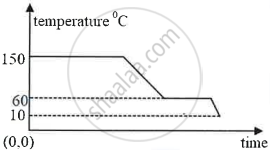Advertisements
Advertisements
प्रश्न
What is meant by latent heat? How will the state of matter transform if latent heat is given off?
उत्तर
- The heat energy required to change substance from one state to another at constant temperature is called as latent heat of a substance.
- When latent heat is given off from a substance, it causes the strengthening of the bonds between atoms or molecules causing a change of state of the substance.
- When a liquid substance gives off latent heat of fusion, strengthening of bonds results into pulling of atoms or molecules of liquid closer and eventually it changes into solid-state.
- Similarly, when a gaseous substance gives off latent heat of vaporisation, strengthening of bonds results into the pulling of atoms or molecules of gas closer and eventually it changes into a liquid state.
संबंधित प्रश्न
State two characteristics of a good thermion emitter.
State any two measures to minimize the impact of global warming.
What is the Greenhouse effect?
1 g ice of 0℃ melts to form 1 g water at 0℃. State whether the latent heat is absorbed or given out by ice.
When a liquid is getting converted into solid, the latent heat is ………………………………
What is the name given to the energy absorbed during a phase change?
Name two factors on which the heat absorbed or given out by a body depends.
What happens to the heat supplied to a substance when the heat supplied causes no change in the temperature of the substance?
When 1 g of ice at 0 °C melts to form 1 g of water at 0 °C then, is the latent heat absorbed by the ice or given out by it?
What observation you will record and how will you determine the specific latent heat of fusion of ice?
Calculate the total amount of heat required to convert 100g ice at 0°C to steam at 100°C.
(Specific latent heat of fusion of ice = 336 J/g, specific latent heat of vaporization of steam = 2260 J/g, specific heat capacity of water = 4.2 J/g°C).
If there is no Heat loss to the surroundings, the heat released by the condensation of m1 g of steam at 100°C into water at 100°C can be used to convert m2 g of ice at 0°C into water at 0°C.
(i) Find:
(a) The heat lost by steam in terms of m1
(b) The heat gained by ice in terms of m2
(ii) Form a heat equation find the ratio of m2 : m1
Specific latent heat of vaporization of steam = 2268 kJ/kg
Specific latent heat of fusion of ice = 336 kJ/kg
Specific heat capacity of water = 4200 J/kg°C
If pressure increases, the melting point of a substance ______.
How fog is formed?
Write the name.
The phase in which solid substances are converted into liquid.
Write scientific reason.
Even if boiling water is constantly heated, its temperature does not rise.
Specific latent heat L = ______.
Who introduced the term latent heat?
The diagram below shows a cooling curve for a substance:

- State the temperatures at which the substance condenses.
- The temperature range in which the substance is in liquid state.
- Why do we prefer ice to ice-cold water for cooling a drink?
